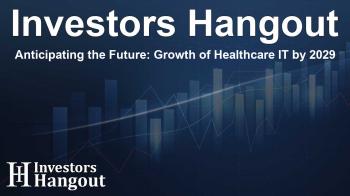Anticipating the Future: Growth of Healthcare IT by 2029

Healthcare IT Market Overview
The healthcare IT market is on the cusp of a significant transformation, projected to grow by USD 215.4 billion between 2025 and 2029. This growth is attributed to an increasing focus on enhancing the quality of services while ensuring operational efficiency. These trends highlight the emergence of AI-enabled solutions such as emotion recognition technologies which are reshaping the landscape of digital healthcare.
Key Market Drivers
Leading the charge in market evolution are factors like e-prescribing, interoperability, and stringent security measures focused on safeguarding patient data. Healthcare organizations are increasingly investing in advanced technological solutions to monitor and manage diseases effectively, coordinate care, and secure patient safety. With more than 6 million hospital beds in active use, there's a heightened necessity for robust IT systems that facilitate seamless communication and data interchange.
The Role of Advanced Technologies
In recent times, healthcare providers have turned to advanced technologies, including AI, to enhance diagnostic accuracy and improve treatment outcomes. AI applications in healthcare are rapidly expanding, with one significant area being emotion recognition technology. This innovation allows telemedicine platforms to accurately assess patient emotions remotely, which is especially useful in telepsychiatry, bridging communication gaps that can affect patients who struggle to articulate their feelings.
Challenges Faced by the Industry
Despite the promising growth trajectory, the healthcare IT sector faces numerous challenges. Issues such as interoperability between different IT systems and persistent security threats are significant hurdles that need addressing. The projected growth of the sector towards USD 735.6 billion by 2025 underscores the urgency for effective solutions that overcome these obstacles. Many smaller healthcare organizations often grapple with outdated infrastructure, which inhibits their ability to fully embrace new IT advancements.
Market Segmentation
The market is segmented based on key end-users, which include healthcare providers and payers, and further categorized by components such as services, software, and hardware. The geographical reach of this market spans across regions, including North America, Europe, APAC, South America, and the Middle East and Africa.
Impact of AI and IoT in Healthcare
AI and IoT technologies are among the primary drivers of innovation within the healthcare IT landscape. These technologies not only enhance data security but also facilitate remote patient monitoring and predictive analytics. The future holds exciting possibilities with the potential for virtual hospitals and telemedicine solutions that could redefine patient interactions. As the population ages, the demand for personalized medicine and geriatric care will only magnify, urging healthcare organizations to adapt swiftly.
Innovative Solutions and Future Outlook
Healthcare systems worldwide are increasingly focusing on integrating cloud-based solutions that augment data storage and accessibility. Additionally, the integration of virtual reality and augmented reality in healthcare is revolutionizing areas like medical imaging and patient management, significantly enhancing care delivery.
Conclusion: Embracing Change in Healthcare IT
The healthcare IT industry is evolving rapidly, with significant emphasis placed on adapting to new technologies and addressing the challenges inherent to these changes. Healthcare organizations must invest in IT solutions, employ trained professionals, and enhance their cybersecurity measures to not only meet but exceed the shifting demands of patient care and management. The continuous advancement in electronic health records and digital health solutions paints an optimistic picture for the future of healthcare IT, where quality care will be synonymous with efficient and secure digital practices.
Frequently Asked Questions
What is the projected growth of the healthcare IT market?
The healthcare IT market is projected to grow by USD 215.4 billion between 2025 and 2029.
What are the major drivers of this market growth?
The key drivers include enhanced service quality, operational efficiency, and the implementation of AI technologies.
What challenges does the healthcare IT industry face?
Major challenges include interoperability between systems and threats to data security, particularly from cybercrime.
How is AI impacting healthcare IT solutions?
AI is revolutionizing healthcare IT by improving diagnosis accuracy and enabling innovative applications like emotion recognition in telemedicine.
What trends should we look for in the future of healthcare IT?
Future trends include the integration of virtual hospitals, telemedicine solutions, and enhanced data analytics driven by AI technologies.
About The Author
Contact Kelly Martin privately here. Or send an email with ATTN: Kelly Martin as the subject to contact@investorshangout.com.
About Investors Hangout
Investors Hangout is a leading online stock forum for financial discussion and learning, offering a wide range of free tools and resources. It draws in traders of all levels, who exchange market knowledge, investigate trading tactics, and keep an eye on industry developments in real time. Featuring financial articles, stock message boards, quotes, charts, company profiles, and live news updates. Through cooperative learning and a wealth of informational resources, it helps users from novices creating their first portfolios to experts honing their techniques. Join Investors Hangout today: https://investorshangout.com/
The content of this article is based on factual, publicly available information and does not represent legal, financial, or investment advice. Investors Hangout does not offer financial advice, and the author is not a licensed financial advisor. Consult a qualified advisor before making any financial or investment decisions based on this article. This article should not be considered advice to purchase, sell, or hold any securities or other investments. If any of the material provided here is inaccurate, please contact us for corrections.

